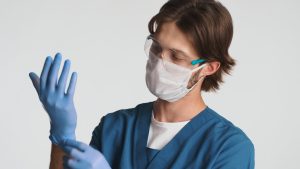Extensive review takes stock of ocular manifestations of COVID-19 infection
The ocular aspects of COVID-19 infection have been the subject of numerous publications and clinical studies, both Italian and international. It may, therefore, be very useful for those wishing to learn more about this topic to refer to this article which presents an in-depth review on the subject
Ophthalmic Manifestations Of Coronavirus (COVID-19)
Hu K, Patel J, Swiston C, et al. Ophthalmic Manifestations Of Coronavirus (COVID-19) [Updated 2022 May 24]. In: StatPearls [Internet]. Treasure Island (FL): StatPearls Publishing; 2022 Jan-. Available from: https://www.ncbi.nlm.nih.gov/books/NBK556093/
To get an idea of the contents, we offer you the Pearls and other issues in translation:
- An ocular spread of SARS-CoV-2 through tears is a possibility of which ophthalmologists should be aware.
- Conjunctivitis and excessive tearing may be the first and, in some cases, the only manifestation in a patient with COVID-19 infection.
- Severe ocular manifestations of COVID-19 have been reported, including retinovascular disease, uveitis, optic neuropathy, and fungal orbital co-infections.
- SARS-CoV-2 can trigger and exacerbate inflammatory/disease conditions.
- Patients may present with chemosis in advanced cases and follicular conjunctivitis.

The examination of the visual apparatus should be carried out wearing gloves and using "extension instruments' (cotton swabs, etc.) to avoid direct contact with secretions.
- Since many patients presenting to the eye clinic are elderly and many also have comorbidities, it is important to prioritise urgency, prior to the visit, and only see patients who need urgent treatment directly. Many of the non-urgent cases can be managed through telemedicine.
- In many countries, a 6-foot spacing has been applied as an anti-COVID-19 safety measure, which clearly cannot be applied in a clinical setting and certainly not within the confined space of an eye laboratory. One suggested way is to admit only one person at a time into the clinic.
- Based on clinical practice, it was found that physicians with a higher risk of being infected include ophthalmologists, ENT specialists and anaesthetists, due to the proximity of examiners to superficial mucous membranes.
- When performing surgery under general anaesthesia, it has been recommended that surgeons and operating staff do not enter the room for 15 minutes prior to intubation or extubation. This standard precautionary measure is applied to all cases of general anaesthesia in many facilities, whether the patient is COVID-19 positive or negative.
For all other details on aetiology, epidemiology, pathophysiology, differential diagnosis, treatment and management, we refer you to this review, complete with an extensive bibliography and illustrative clinical images.
On our site on Covid-19 you can find
n. 1; n. 2; n. 3; n. 4; n. 5; n. 6; n. 7; n. 8; n. 9; n. 10; n. 11; n. 12; n. 13
